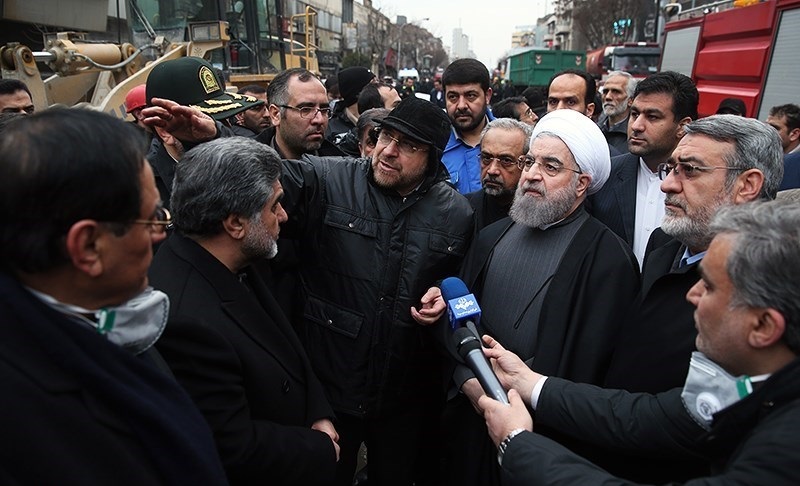by Fareed Marjaee
Recently the neo-conservative writer Eli Lake of Bloomberg Views interviewed Iranian exiled dissident and Nobel Laureate Shirin Ebadi. He chose a highly charged title for the interview: “Shirin Ebadi Is Done Trying to Reform Iran. She Wants Regime Change.” Ebadi, an established lawyer in Iran who also took on human rights cases, left Iran some years ago. She is now part of the opposition outside the country.
Eli Lake claims that Ebadi is seeking the Trump administration’s assistance in changing the regime in Iran. In the interview, she is not advocating a U.S. military attack on Iran but is rather proposing additional sanctions. However, many in the opposition in Iran interpret the term “assistance” to mean some type of “intervention.”
Eli Lake’s hawkish orientation and his writings against the Iran nuclear deal give the interview a particular slant. Lake has also refused to release the complete transcript of the interview, so it’s difficult to assess the extent to which Ebadi has moved away from a reformist approach.
Still, Ebadi’s recent position on “regime change” and “reform” in Iran was quite controversial. In so far as it can provide insight into the debates within the opposition, her comments have been helpful and important.
Evolution of an Opposition
At this stage, four decades after the Iranian Revolution, civil society has evolved in such a way that a significant section of the Iran population and the opposition aspires for a political system (and a constitution) that is democratic and based on human rights. However, many Iranians are clearly weary of the upheaval of a violent regime change and foreign intervention.
Outside the country, some members of the opposition have implicitly called for military intervention in Iran. Why has the opposition outside the country evolved differently? And why is there a schism between the reformist opposition inside the country and the outside opposition? (Note that the Reformist organizations connected to the former President Mohammad Khatami are only a section of the larger reformist coalitions.)
The inside opposition aspires for measured steps and pace of change, so the situation does not lead to chaos. Most Iranians don’t want their everyday lives disrupted or the territorial integrity of their country challenged. “Territorial integrity” is more than merely geographic or physical. It is also political and existential. In this context, any references to separatist or secessionist discussions in a “federalist” framework are taboo. Ebadi’s recent participation in conference panels with secessionist figures has caused concern for many in the mainstream opposition. To confront Iran in the past, foreign interests have played the separatist card in the border provinces of Kurdistan, Azerbaijan, Baluchistan, and Khoozestan.
The majority of the reformist opposition is still attached to the original, emancipatory ideals of the 1979 revolution. Also, the domestic opposition is historically opposed to foreign involvement because of what happened in the early 1950s when, under the leadership of Mohamad Mosaddeq, Iran nationalized the oil industry and fought off foreign influence in Iran’s internal affairs. The CIA and MI-6 overthrew the reformist and democratically elected Mosaddeq government in a joint operation code-named TPAJAX.
The demonstrations of the Green movement following the disputed presidential elections of 2009 took place in a completely different regional context. That was before the Arab Spring and the turmoil that threatened the social-political fabric in Libya, Yemen, Egypt, and Syria.
Now, however, in the domestic discourse of Iran, any threat to the social fabric of the society is very real and immediate—it affects the immediate everyday lives of the general public. However, to policy hawks in Washington, instability in the neighboring countries is only of interest in an academic or policy sense. The neocon policy hawks who push for military provocations and the destabilization of Iran wouldn’t personally suffer the consequences of the subsequent chaos. The actual people on the ground in Iran would suffer the consequences.
In debates within the opposition in Iran, the reformists have raised the alarm about a possible Syrian case of social disruption. Indeed, “Syria” has become shorthand for the kind of social or political destabilization to be avoided. Many outside-opposition actors, on the other hand, tell the nation not to be worried about any turmoil or a “Syrian type crisis” for Iran. But if the social fabric of a country falls apart, the policy hawks can move on to the next project. They won’t be held accountable. During the 2006 bombardment of Beirut, for instance, Condoleezza Rice was quoted as saying that creative chaos is better than the existing social order. “These are the birth pangs of the New Middle East,” she concluded.
The orientation of the outside-opposition is based on theoretical observations from a distance. That’s because it doesn’t have to negotiate with the realities on the ground. Because of the geographical (and hence political) distance, a different vision and set of political parameters develop. Thus has the outside-opposition evolved in a different direction from the reformist approach of the internal opposition.
The Recent Protests
During the disturbances of December 2017, the leading reformist inside-opposition voices such as Abbas Abdi, Jala’iPour, Tajzadeh, and former President Khatami issued statements against the demonstrations, because they were chaotic and not in line with overall reformist character.
On the other hand, the leading opposition figures outside the country were trying to radicalize the pace of the events. In his messaging, former President BaniSadr asked the police cadre to disobey orders. In video messages, Ebadi asked Iranians to refrain from paying their utility bills and to withdraw their savings and money from the banks. Hassan Shariatmadari sent a message in Azeri dialect to the people of Tabriz to rise up. Mohsen Sazgara and M. Hosseini pushed for violent mobilization and attacks on public institutions. The middle class and the working class did not respond to this type of messaging, which seemed amateurish and disconnected from Iranian realities.
The Union of the Fishermen of the South, which had earlier been on strike, broke their strike just to show that they were not part of the December disturbances. Other unions, such as the bus drivers and Sarcheshme copper mine unions, ignored the non-reformist opposition calls. The working class seems to believe that turmoil in the country will not lead to improved labor conditions. The campaigning of some of the leftist student activists in the universities, meanwhile, has been focused on the new labor law and the possible privatization of higher education.
The central point is that the outside-opposition political discourse is not gaining traction. During the most recent presidential elections in Iran, the outside-opposition repeatedly asked the people to boycott the elections. But the participation rate was notably high: more than 73 percent of eligible voters. And Hassan Rouhani got elected for the second time. The gap between the aspirations of reformists inside Iran and the opposition outside the country is as large as it has ever been.
Fareed Marjaee is a writer and commentator with the reformist newspaper Etemaad.






Reform is always a better way than any other destructive way. Any harsh force on society has consequences that should be payed for a long time. Overthrow of Qajar dynasty causel loosing all the power that was transfered to people and had consequences like Mosadegh overthrown and 1979 revolution. And the forign meddling has been apparent in all.
I wonder when the Western world would free itself and see truth behind the “white man’s burden” parroted by the MSM. What a race…
The only problem with the reformists in Iran is that they are the other side of the same coin created for regime’s longevity. This became very clear when Khatami who was supposedly banned from public speaking, immediately after the recent uprisings, gave a speech blaming the protesters and defended the Sepah. Rohani called all Iranians Sepah members. There are no reformists in Iran. A mullah is a mullah, reformist or conservative is the same crap. What has exactly reformed in 40 years. More arrests and murders now. Human rights is non existent and the judiciary is just as corrupt that it has ever been. If you call Aghazadeh owning everything in the country masked as private ownership reform then you need to have your head examined. There is no evidence of reform. It is just a ploy but the ruling class.
What exactly has reformed in 40 years is that Iranians are living longer, better lives than ever, having added 22 years to average life spans, literacy rates are not under 50% anymore, and people actually vote regularly in heated elections. The better question to ask is what have the exiles accomplished in the last 40 years other than to name-call and fight and bicker and provide comfort and aid to the “regime-change” Iran hawks in Israel and Washington.
It is very enlightened and informative article.
If more explanation was given about this last sentence:”The gap between the aspirations of reformists inside Iran and the opposition outside the country is as large as it has ever been”; it could have been more elucidated for your readers to know who are the people whom truly, are representing and advocating the reformist approaches inside Iran. Many Thanks.